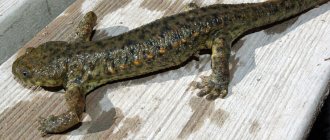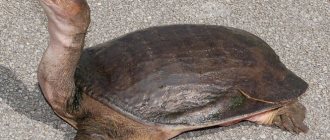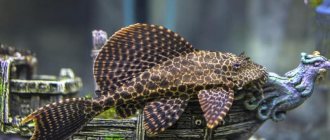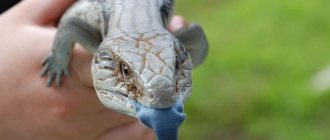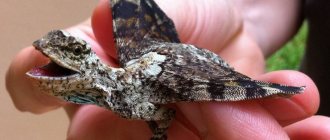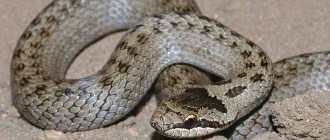Dwarf newt (Hypselotriton orientalis) David, 1873.
A funny, cute amphibian with interesting behavior, which is very popular in America and Europe, and has recently attracted more and more attention from pet lovers in our country.
Family: True salamanders Genus: Hypselotriton Species: Pygmy newt
Synonyms
Triton orientalis (David, 1873) Triton pyrrhogaster orientalis (David, 1873) Diemictylus orientalis (David, 1873) Triturus orientalis (David, 1873) Cynops orientalis (David, 1873)
The fire-bellied newt is also called the Chinese red-bellied and Chinese fire-bellied, oriental and dwarf newts
. It received all these names due to its unusual coloring and tiny size. Among its genus, it is the smallest newt.
History of the breed
Newt is the common name for a group of animals that belong to the order of tailed amphibians. They live in water and on land and have the ability to regenerate. Some species are suitable for keeping in an aquarium, for example, the Spanish golden newt. The Chinese red-bellied newt is especially popular for home keeping. This most numerous species of tailed amphibians comes from the genus of East Asian amphibians and belongs to the family of true salamanders.
The Chinese newt is closely related to the Japanese fire-bellied newt. Representatives of the family are similar in appearance to each other. The main differences between individuals are the size, shape of the head and tail.
Important!
In everyday life, it is customary to call the aquatic representatives of the family “newts,” and the land species “salamanders.”
The red-bellied newt is a cute little amphibian
Nutrition
The dwarf newt (Hypselotriton orientalis) has such a mouth
Under natural conditions, fire-bellied newts living in water eat mainly invertebrates, as well as small fish, amphibian larvae and tadpoles. On land they feed mainly on invertebrates.
In a terrarium, you can feed tubifex, bloodworms, crickets, both banana and brownie, worms, as well as pieces of fish and meat.
The larvae are fed with small invertebrates: small daphnia and cyclops, and as they grow, cut tubifex and bloodworms are added to the diet. You can also use specialized feed.
Dwarf newt (Hypselotriton orientalis) feeding process
Feeding larvae and young individuals should be daily, and adult newts – once every 2 days. It is helpful to include calcium mineral supplements in your diet, such as crushed eggshells. Ready-made vitamin supplements are used only strictly according to the instructions and no more than once a month.
Types of Chinese newt
Newts with orange or red bellies from different genera form the group of tailed amphibians. All presented types have similar content requirements.
Short-legged
The short-legged newt's habitat is southeast China. Large species, body length of the amphibian is 15-19 cm. The head is flat and wide, the eyes are relatively small, the muzzle is short. Labial folds and parotid glands are pronounced. There is a vertebral fold on the back, there is no crest. The tail is round at the base, compressed at the sides and rounded, making up half the length of the body. The limbs are powerful, but short.
The skin is smooth, with vertical folds running along the sides of the body. The main body color is heterogeneous, alternating with different shades of gray and light brown tones interspersed with black spots. The abdomen is bright, with uneven colors of whitish, pink and red spots. Males and females do not differ in color.
The short-legged newt is the largest species, the length of which can reach 17-21 cm
Firebellied
In nature, the fire-bellied newt lives in Japan. Body length 14 cm. The head is slightly elongated square, the body is slender, the tip of the tail is sharp. The labial folds are well developed and there is no ridge on the spine. An active and peaceful species.
It has a dark brown color, the male’s lower ventral side is bright red, the female’s is bright orange. The skin has a grainy texture.
The body length of the fire-bellied newt is average - 8-13 cm
Red-bellied
The red-bellied newt is native to the west coast of the United States. The animal is large, growing up to 20-22 cm in length. The body is slender, with powerful limbs, the head has a slightly narrowed muzzle and large eyes. The comb is missing.
The skin is lumpy with contrasting colors. The outer part of the body is brown or brown varying from light to dark tones. The abdomen is usually orange or red, sometimes with dark spots.
Red-bellied newt is the smallest subspecies, reaching 8-10 cm
Blue-tailed fire-bellied newt
The blue-tailed fire-bellied newt is native to southern China. A miniature amphibian, the length does not exceed 10 cm. The body is elongated, has a vertebral and V-shaped occipital crest, the muzzle is short and wide. The parotid glands are not expressed. The tail is flat, shorter than the body, gradually narrowing and rounded towards the end.
Body color is brown, light and dark tones, sometimes brown or olive. The upper part of the spine is lighter in color, the lower ventral side has contrasting orange or red spots on a black background.
The color of this species can vary from golden yellow to dark brown.
Interesting fact!
Males are slightly smaller than females and have black spots on their tails. During the mating season, their tail turns bright blue.
Okinawan or horseshoe crab
The Okinawan newt lives on the southern Japanese islands. A large amphibian, sometimes reaching 18 cm. The body is long, the vertebral crest is not clearly expressed. Large head, parotid glands not very prominent. The tail is long, narrow and straight.
The skin is smooth, with uneven color. The base color varies from dark brown to black in some places. The underside of the limbs and abdomen are bright orange, with chaotic black spots, which can sometimes even merge.
Individuals of both sexes have the same color and differ only in size. The female is larger than the male. Horseshoe crab newts can be classified as heat-loving species.
The horseshoe crab newt got its name from its long, straight tail.
Striped newt
The habitat of the striped newt is southeast China. The size of a mature animal is up to 12 cm. The body is slender, elongated, the forelimbs are slightly longer and thinner than the hind limbs. The head is smooth, slightly concave, the parotid glands are underdeveloped. The tail is almost equal to the length of the body, with a dorsal ridge and a sharp tip.
The color of the upper part is brown to black. The ventral part is bright orange, with black spots of irregular shape and an intermittent stripe. The tail is bright, heterogeneous in color, the color transitions from orange-red to pale orange, brown. Males differ from females in having a swollen cloaca and a more developed tail crest.
All species of red-bellied newts cannot live without an aquatic environment. Young individuals do not have a land stage of development.
Striped newts are a very rare species.
Description
The maximum body length is 10 cm. The species is distinguished by a red belly.
Appearance
The main color is dark brown to black, sometimes fading to gray. The abdomen is red or orange with black spots. There are individuals with orange dots and lines on the paws and back. The sex of the animal does not affect the color. The long tail is rounded at the end.
Behavior
The amphibian leads a terrestrial and underwater lifestyle. The preferred habitat may not change for months. The period of residence in water is accompanied by activity during daylight hours: the amphibian moves along the bottom, climbs onto plant leaves and glides down from them. On land, red-bellied fish lie motionless, at night they climb the walls of the aquarium and can even run away. The character is peaceful, sometimes aggressive towards small species.
Lifespan
In good conditions, the newt lives 10–11 years.
Keeping at home
Unlike other tailed amphibians, red-bellied newts are considered aquarium animals. They are easy to care for and, under favorable conditions, easily reproduce in captivity.
Home improvement
When arranging housing for newts, it is necessary to take into account the needs of the animals and create conditions as close as possible to their natural habitat.
For two adults, a small panoramic aquarium of 20-30 liters will be enough. It must be tightly closed with a lid, since newts can crawl out of the aquarium even in those places where communication tubes pass that support life in the aquarium. Air exchange is ensured by protected feeding openings.
For an aquarium that will be inhabited by amphibians it is typical:
- the tank is not completely filled with water;
- islands and structures protruding above the water surface;
- abundant vegetation;
- decorations for sheltering animals.
Surface objects cause newts to come to land, as in nature. For these purposes, tall driftwood and stones are immersed in the aquarium, and artificial islands, ladders, foam bridges or corks are built. Floating devices must be partially submerged in water so that the animal can easily climb up them, go out onto land to dry out and rest. A stationary island with a ladder can be made of plexiglass or non-fragile plastic and glued to the walls of the aquarium above the water level.
The difference from a simple aquarium is in a special land island
Water
An amphibian aquarium is filled with 20 cm of water. Once every two weeks, 1/3 of the total volume of water is replaced with fresh water. Only clean water is poured into the aquarium and left to sit for at least 2 days. Newts are sensitive to the presence of chlorine, but easily tolerate temporary organic pollution. Otherwise, animals are not picky about the chemical composition of water, but are sensitive to temperature conditions.
| Optimal physical and chemical parameters of water for keeping Chinese newts | |
| Acidity | 5–7 pH (slightly acidic) |
| Rigidity | 4-8 dGh (soft) |
| Water movement | absent (weak) |
| Temperature values | |
| Autumn winter | spring Summer |
| 12-16°C | 19-23°C |
Note!
Amphibians cannot tolerate increases in water temperature above normal. If there is no air conditioning in the room where the aquarium is located, then the water must be constantly cooled, avoiding sudden changes in temperature.
Autonomous cooling can be achieved using a chiller. This unit automatically maintains the set temperature, is silent, and costs about 30,000 rubles.
You can equip a cooling system without special devices by placing two small ice generators (plastic bottles, bags, batteries) on opposite sides of the aquaterrarium. Using the same principle, ice is placed in the filter. These cooling methods require constant monitoring of water temperature and uniform distribution of cold.
Water temperatures above 26°C are critical for newts and can lead to their death.
To avoid poisoning the newt with chlorine, the water must first be left for several days.
Aeration
Adults do not need aeration. They float to the surface and breathe atmospheric air. When keeping other species of animals together with newts, a low-power compressor is installed in the aquarium. This approach to the selection of equipment will help to avoid excessive flow in the tank and will have a beneficial effect on all inhabitants of the aquaterrarium.
Short-term aeration for sexually mature individuals is started during the mating period. Only young animals need full aeration. They need to constantly saturate the water with oxygen, until the structure of the gills in growing individuals changes.
Plants
Newts feel comfortable when the aquarium is densely planted with a variety of living plants. Aquacultures will serve as a reliable shelter for amphibians, allowing them to climb on them, climb over branches, and effectively glide in the water.
Preference should be given to underwater and aquatic hard-leaved plants.
Requiring rooting:
- Anubias;
- hygrophila;
- elodea;
- cryptocoryne;
- arrowhead
Behavior and Compatibility
Gets along well with dwarf frogs, corydoras catfish, rainbowfish, tetras, gouramis, and laliuses.
It is not advisable to keep newts together with aquatic turtles, cichlids, clawed frogs and other large predators.
Wintering for newts lasts 2 months - October-November. From December to May – sexual activity.
You need to prepare for the wintering period by strictly observing certain conditions. Two weeks before wintering, the temperature and daylight hours gradually decrease. Then the newt is placed in a special cage with peat moss (sphagnum) and placed in a place where the temperature is not higher than 15-17°C. After 3 days, the cage should be placed on a shelf in the refrigerator at a temperature of +5-8°C. If the animal is healthy, wintering lasts the required 2 months, and removal from it takes place in the same mode as preparation for it, that is, by gradually increasing the temperature and increasing the duration of daylight hours.
Breeding
After the animal has overwintered and adapted, the mating period begins. Newts reach sexual maturity at 3 years. Stimulation for reproduction will be aeration and raising the water temperature in the aquaterrarium to 23–24ºC.
During the mating season, the male attracts the attention of the female. This is manifested in sweeping movements of the tail, the tip of which trembles slightly. When compatible, the couple begins the process of mating and fertilization - the spermatophore released by the male is deposited in the female’s sperm duct.
Compatibility in comparison with other aquarium animals
For newts, a species aquarium is preferable. They cannot be housed with tropical fish due to the difference in required temperature conditions. In addition, newts are predators, and they will eat anyone they can. Fish, in turn, can bite their legs and tails.
Newts of other species are larger and many of them show aggression when dividing territory, so fire-bellied Chinese will constantly be in stressful conditions with them. It is strictly forbidden to add crabs and crayfish. As a last resort, medium-sized peaceful fish and, for example, Hymenochirus frogs can be placed in the aquarium with dwarf newts. Large shrimp get along well with newts (they eat small ones).
Diseases
Fire-bellied newts are hardy animals. They have good health and are little susceptible to disease.
| Factors causing diseases | ||
| Errors in care | Injuries | Diseases, stress |
| Unsuitable physical and chemical characteristics of water | Sharp aquarium elements | Bending |
| Insufficient hygiene of the aquaterrarium | Frequent contact with human hands | Parasites |
| Unbalanced diet | Aggressive, incompatible neighbors | Infections |
| Poor quality food | Incompatible species | |
Most often, Chinese newts are susceptible to fungal and bacterial diseases. The source of pathogens may be other sick animals in the aquarium or infected food. Unhealthy individuals should be immediately removed from the common tank.
The presence of diseases may be indicated by:
- Poor appetite.
- Long stay on land.
- Loss of coordination.
- Plaque, ulcerative lesions, wounds and scabs on the skin.
- Cloudy eyes.
- Swelling of part of the body.
- Lethargy.
Veterinary clinics cannot always diagnose the disease; this requires laboratory equipment. Therefore, specialists practice complex treatment, immediately against all factors provoking the disease.
The following drugs are usually combined:
- Antifungal - nystatin.
- Antimicrobial - ciprofloxacin or trichopolum.
For treatment, take one tablet of the drug from each group, dissolve it in a small amount of water and the resulting solution is diluted in a 10-liter tank.
Open wounds are disinfected with antiseptics, and Melafix (a natural broad-spectrum remedy) is added to the water.
Important!
Newly purchased animals must be quarantined and regularly inspected before being added to a community aquarium. This will prevent mass infection if the animals turn out to be unhealthy.
Feeding
Dwarf newts feed on any live food - large bloodworms, earthworms, crickets, as well as meat, fish, seafood, which is best given in small pieces from tweezers; they prefer mobile food.
Of course, live food is healthier for them, but it can cause infectious and parasitic diseases, so you need to be careful with it. To avoid the risk, you can, for example, dig for earthworms yourself in uncontaminated places or buy cricket larvae from amateurs who breed them .
The diet of newts needs to be varied as much as possible. It is sometimes recommended to add crushed eggshells as a source of calcium or special vitamins for amphibians; some experts recommend periodically dripping Fishtamin into the aquarium water or food as a source of vitamins.
Over time, newts can be accustomed to dry food. Adults are fed once every two or three days, young ones - daily. It happens that completely healthy animals can refuse food for several days or even weeks. If they have no other signs of illness or stress, you just have to be patient, sooner or later your appetite will return.
Interesting Facts
Regeneration significantly extends the life of newts. They are able to restore not only lost limbs, but also eyes and even internal organs.
Some newts briefly change the color of the skin on their back from dark to light shades, while the ventral side does not change color.
Moist skin is protected by a special secretion that retains moisture inside the body and prevents pathogens from penetrating the mucous membrane and infecting the animal.
Chinese aquarium newts easily get used to their owners, are able to recognize them, and are quite smart.
Reproduction
After wintering, the temperature in the aquarium is raised to 24°C, aeration is turned on, and the newts begin to reproduce. Their fertilization is internal: the male lays a spermatophore, which the female draws in with her cloaca, and then, after 2-3 days, spawns up to 300 eggs, attaching them to plants. If there are no living plants in the aquarium with newts, small strips of polyethylene can be placed there as a substrate for eggs.
The clutch must be removed to another aquarium or the adult newts must be removed, otherwise they may eat the eggs or larvae. After a day or two, the dead eggs are removed, leaving only those eggs that remain transparent, and the embryos in them have turned from balls into something like commas.
Some time after laying eggs, newts usually molt and eat their old skin, and then often enter another land phase.
The larvae hatch in 2-4 weeks. At first they are very small, resembling thin lines with a prominent head; in a general aquarium with soil and plants they are practically invisible. Only when worried do they scatter to the sides like specks.
They are fed live dust - ciliates, rotifers, Artemia nauplii. If there are few larvae and they live in the main aquarium with a stable biological balance and living plants, there are plenty of small food organisms there. You can additionally place several ampularia snails with the larvae, the mucus of which promotes the reproduction of ciliates.
When the larvae are kept in a special nursery aquarium, they are fed several times a day with Artemia nauplii or specially grown ciliates. As the larvae grow, they switch to feeding on larger animals, preferably daphnia. In the future, you can start feeding them chopped tubifex and small bloodworms, but this must be done carefully, since there is a great danger of introducing parasites or infection with this food.
It is much safer to give babies home-grown daphnia right up to metamorphosis, and then try to immediately switch to feeding shrimp fibers with tweezers. It is ideal if it is possible to feed newts with home-bred Aulophorus or Enchytraea worms, as well as fry of aquarium fish or juvenile freshwater shrimp.
Newt larvae and juveniles do not require special conditions for keeping them; all they need is aeration, regular cleaning of the aquarium, and a temperature of about 22°C.
Due to the branched external gills on the sides of the head and large mouth, the grown larvae are very funny, they resemble small smiling tailed Cheburashkas. The color of the babies is usually dark gray or brownish, the abdomen is paler.
Metamorphosis of the larvae - the loss of external gills and a change in the structure of the skin - occurs gradually at the age of two to four months, at which time they are 3-4 cm long. The larvae begin to emerge and swallow air from the surface of the water. At this point, they need to be provided with the opportunity to go to land, that is, place an island in the aquarium that would be easy to get out to.
Sometimes after metamorphosis, young newts may refuse food for several days. Further, they are cared for in the same way as for adults. They can be placed in a common aquarium with their parents as soon as they grow so large that adult newts cannot swallow them. Young newts usually enter the aquatic phase 2-3 months after metamorphosis. Dwarf newts reach sexual maturity at the age of 1-3 years.
Reviews
Chinese newts are not the most common inhabitants of aquariums, but this is what makes them interesting. Their way of life and special habits are not typical of traditional animals that are usually kept in an aquarium. A small corner of wildlife recreated at home with extravagant newts will give you many new emotions with these inhabitants of the aquatic ecosystem.
Would you like to purchase a newt for your own aquaterrarium? Share in the comments!
Varieties of fire-bellied newts and population situation
Unfortunately, some members of the fire-bellied newt species are extinct, while others are considered very rare.
This situation is associated with pollution of their habitats, changes in biotopes, trade and capture from the natural environment.
The most numerous are the newts Cynops orientalis, they live throughout the eastern part of China, and the ranges of C. cyanurus, C. chenggonensis, C. wolterstorffi and C. orphicus are extremely small. Newts C. pyrrhogaster are also quite numerous and live on the main islands of Japan.
Fire-bellied newt (Cynops pyrrhogaster).
The species C. orphicus is so rare that it is practically unheard of, but a population exists in captivity and breeding programs are underway to breed these newts. The species C. cyanurus is rarely found in nature, but it is bred in terrariums by enthusiasts, and C. wolterstorffi is generally considered extinct.
Among terrarium keepers, 3 species are most common: C. orientalis, C.ensicauda, and C. pyrrhogaster.
